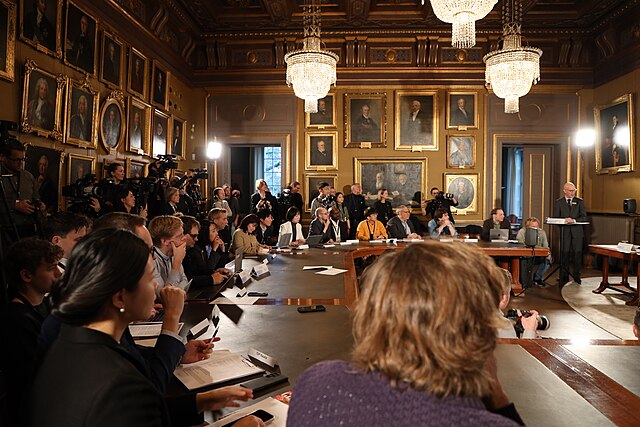
WIKIMEDIA COMMONS | Over the years, Nobel Prizes have honored scientists whose decades of research led to discoveries that continue to shape the future of science and have practical applications in today's society.
From Oct. 6-8, the Nobel Foundation announced the recipients of the Nobel Prize in physics for advances in quantum mechanics, the prize in physiology or medicine for immune system breakthroughs and the prize in chemistry for developments in metal-organic frameworks.
John Clarke, Michel H. Devoret and John M. Martinis received the prize in physics for the discovery that quantum mechanics — such as quantum mechanical tunnelling, the process in which particles pass through high-energy barriers — can occur in larger electrical circuits than previously thought. Mary E. Brunkow, Fred Ramsdell and Shimon Sakaguchi won the physiology or medicine prize for their discoveries about the peripheral immune system. Susumu Kitagawa, Richard Robson and Omar M. Yaghi received the prize in chemistry for their work with metal-organic frameworks (MOFs), materials made up of metals connected to each other by other organic molecules.
Clarke, Devoret and Martinis’ work built on previous discoveries that found microscopic particles to be capable of passing through an energy barrier. The trio demonstrated that fairly large objects could still behave quantum mechanically, laying the foundation for the first quantum computers, theoretical computers that use the principles of quantum mechanics to perform vastly more complex calculations than traditional computers.
Christopher Lobb, a former University of Maryland physics professor and affiliate researcher in Georgetown University’s physics department, said he personally knows the Nobel laureates in physics and thinks their work is particularly deserving of the prize.
“I think it’s wonderful. I’ve been waiting for this to happen for more than 20 years,” Lobb told The Hoya. “I know all three of them personally, and two of them fairly closely, and they’re not just extraordinary scientists, but they’re wonderful people.”
Lobb added that the physicists’ discoveries highlight the field’s real-world applications, comparing the applicability of their work to research with the Large Hadron Collider, the world’s largest particle accelerator that propels charged particles at high speeds for research.
“Sometimes we think about physics as being things like the big accelerator at CERN or cosmology — and that certainly is physics, and it’s an important part of it. But, most physicists work on things that are surprisingly connected to the real world,” Lobb said. “And I think this is just a reminder of how important physics is for broader applications.”
Brunkow, Ramsdell and Sakaguchi’s work led to the discovery of regulatory T-cells, a type of immune cell that plays a crucial role in maintaining immune tolerance and overall health.
Steven Singer, director of Georgetown’s biology of global health program, said the trio’s work identified a crucial gene involved in producing and maintaining regulatory T-cells, which is essential for many bodily responses to illness.
“The work of these Nobel prize winners helped identify a key gene involved in production and maintenance of these cells, as well as describing the overall ability of these cells to block unwanted immune responses from developing in the body,” Singer wrote to The Hoya. “Together, their work resolved a long-standing controversy in the field.”
Singer added that the biologists’ discoveries reveal how regulatory T-cells help the body distinguish between native and foreign cells, resolving key questions about immune tolerance and paving the way for future therapies.
“This work is important for medicine as many new therapies are being developed to increase the activity of regulatory T-cells to help control autoimmune and inflammatory diseases, including Crohn’s disease, rheumatoid arthritis, multiple sclerosis and many others,” Singer said. “I don’t know of any therapies for human diseases based on regulatory T-cells that have been approved yet, but there is significant interest in applying them in these kinds of scenarios.”
The prize awarded in chemistry set the scientific foundation for various applications that can help combat harmful environmental effects and promote clean energy usage.
Song Gao, a Georgetown chemistry professor, said MOF-based materials have a high potential for environmental and energy applications, including curbing air and water pollution, mitigating climate change and generating clean energy.
“For environmental mitigation, MOF materials may be used for adsorption of greenhouse gases, harmful gases, heavy metals and particulate matter and even potentially the photocatalytic degradation of certain PFAS,” Gao wrote to The Hoya. “These applications can be extended to gas, water, soil and other environmental systems, due to the highly porous structure and immense surface areas of the MOF.”
Lobb said that while the awarded discoveries hold potential for positive change, scientific achievement alone may not be enough to bridge the gap between researchers and the public.
“I understand why some people mistrust science. I think that what we need is more understanding of both sides,” Lobb said. “I think we need, as scientists, to play a bigger role in explaining what we do in a way that doesn’t drive people away.”